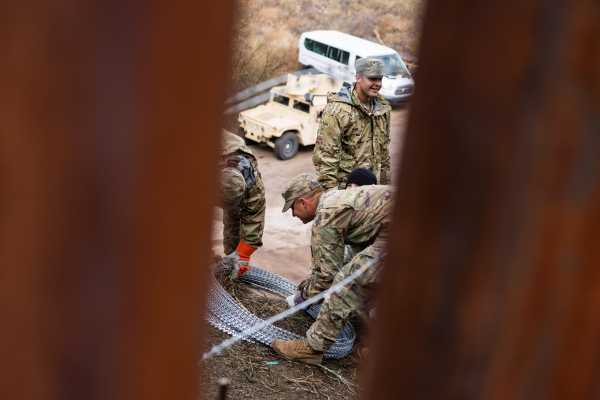
The Department of Defense is moving $1 billion out of a military personnel fund to be used to construct 57 miles of border “wall” — provoking strident (but impotent) objections from Democrats in Congress and setting up a big fight over next year’s Pentagon budget.
On Monday night, acting Defense Secretary Patrick Shanahan issued a letter to the Department of Homeland Security informing them that he’d made $1 billion “available” for wall construction, by moving it into a military account for drug enforcement — one of the three pots of money the Trump administration is tapping under its declaration of national emergency. (The logic is that the wall will impede drug-smuggling corridors, though all available evidence suggests that the majority of drugs smuggled into the US through Mexico come via official ports of entry.)
Leaders of the congressional committees overseeing the Pentagon that same day got notification of $1 billion in “reprogramming” — shifting funds from one government agency or account to another — from the military-personnel fund to the drug-enforcement fund.
House Armed Services Committee Chair Adam Smith (D-WA) formally rejected that notice in a letter today: “The committee does not approve the use of Department of Defense funds to construct additional physical barriers,” he wrote.
But the letter was meaningless.
As Smith himself acknowledged while questioning Shanahan in an oversight hearing Tuesday, the request was unilateral — it wasn’t sent to Smith and Congress for approval, and it’s not something they have the ability to stop. The only thing that congressional Democrats can do now is to reduce the Pentagon’s ability to shift money around going forward — and that’s just what they’re threatening to do.
The Pentagon isn’t asking Congress to move money for the wall. It’s telling them.
In December, Trump allowed the federal government to partially shut down as a way to pressure Congress to give him $5.7 billion in funding for physical barriers on the US-Mexico border. Congress won that standoff, ultimately giving him only $1.375 billion — but he instead declared a national emergency, using executive action to unlock billions more in wall funding from other government funds.
In order for Trump to take the $2.5 billion he promised out of the Pentagon drug-enforcement fund, though, some money had to be put into that fund from elsewhere.
Congress is in charge of setting budget levels for the executive branch for a given year, but reprogramming allows the executive branch to move some of those funds around if the need arises. Whether the executive branch is expected to ask the approval of relevant congressional committees, or just notify them, varies from department to department — and depends on how much money is being used and what it’s being asked for.
Technically, the law doesn’t allow Congress to force the Department of Defense not to reprogram money. (At least, that’s most analysts’ reading of a 1983 Supreme Court decision striking down “legislative vetoes.”) But it’s been standard operating procedure — what Smith called a “gentleman’s agreement” — that the DOD will ask Congress’ blessing before moving large amounts of money around. In fact, the form sent to Congress on Monday is technically supposed to be used for cases in which “prior approval” of Congress is needed.
In this case, though, Smith acknowledged to Shanahan Tuesday that “you are not asking for our permission” or even a blessing; the DOD was going forward with the transfer whether Congress approved of it or not.
Smith described such a decision as unprecedented. But it’s something he and congressional Democrats were worried would happen when Trump signed the emergency declaration. And they made it clear that if it happened, they would take it out on the Pentagon next year — by stripping the department of its power to move any money around at all.
While Congress can’t affect reprogramming authority for 2019, it can reduce the amount of money the Pentagon is allowed to reprogram in fiscal year 2020. And House Democrats on the Appropriations and Armed Services Committees have promised to “zero out” reprogramming if the wall money was transferred without their approval.
Shanahan knew that. He told Smith that it had been a “difficult decision” to authorize the $1 billion and risk angering Congress, but that the circumstances required it.
It’s not totally clear whether the Democrats leading these House committees will be able to persuade their Senate Republican counterparts to reduce reprogramming power. Senate Armed Services Committee Chair Jim Inhofe (R-OK) told reporters when the idea was first floated that “the president does have the authority to” move money around without permission — implying that he wouldn’t be likely to punish the Pentagon over such an action. But it sets up a major fight in fiscal year 2020 over Pentagon funding, which has generally been easier to pass than some other appropriations bills.
One of many streams in the border wall funding debate
Between three years of congressional appropriations, the executive actions Trump took in February (some of which required the emergency declaration), and the White House’s 2020 budget request, it’s hard to keep track of how exactly Donald Trump is making American taxpayers pay for the wall he so badly wants. But it’s important to follow because it’s the best indication of how much has actually been done so far.
- Past appropriations bills: $1.7 billion, 108 miles. Congress gave Trump $341 million for barriers in 2017, and $1.375 billion in 2018 (though Democrats at the time stressed that such money didn’t count as “wall money” because it was specifically dedicated to replacement of existing barriers). Most of the 2017 projects have been completed — as of December, 34 of 40 miles had been built. DHS is currently working through its project load from the 2018 funding, with at least one project (levy wall in the Rio Grande Valley) under construction; others under contract; and a few set to be contracted before the end of this fiscal year. The $1.375 billion appropriated by Congress in the February bill extending 2019 funding has not yet been doled out.
- The Treasury Forfeiture Fund: $600 million. Of the three executive-branch funds that Trump decided to use to get billions more in border-wall funding beyond what Congress appropriated, the easiest one to raid was the Treasury Forfeiture Fund — which collects the money federal law enforcement agents seize from defendants (and the proceeds of auctions for other seized assets like boats and ostrich leather jackets). Congress uses the forfeiture fund to pay for things all the time (over $12 billion has been tapped by Congress over the last decade, according to a Roll Call analysis) and it didn’t require an emergency declaration for Trump do to the same. Trump is reportedly seeking to take $242 million (the amount of the fund’s 2019 surplus over what Treasury expected to take in) out of the account now, and another $358 million later after more assets have been seized. But he doesn’t appear to have done this yet.
- Pentagon drug-enforcement funds: $2.5 billion. This is the account that the Pentagon has just used for its initial $1 billion outlay. It’s expected to use another $1.5 billion this year, though it’s not clear whether that money will also be transferred from its military-personnel fund to the drug fund or whether it will come from elsewhere.
-
Military construction funds: $3.8 billion. This is the most contentious of the national-emergency moves — and the one the Trump administration is slow-walking the most. For one thing, there are constitutional challenges as to whether it’s appropriate for the military-construction budget to be used for the wall — part of the administration’s court battle over the emergency declaration (which hasn’t yet resulted in any actual impediments to Trump’s plans).
Just as importantly, though, there are political considerations — the Pentagon will have to cut other planned construction projects, and risk the anger of the members of Congress where those projects would be happening. The Pentagon has released a list of projects that might be cut to free up $3.8 billion in wall money, but none of them are supposed to happen until 2020 — and the administration’s 2020 budget request would make up the money. In other words, if Congress gives the Pentagon what it wants in 2020, it won’t have to cut anything to pay for the wall. (But that now looks unlikely.)
- The 2020 budget request: $8.6 billion. This is basically a pipe dream. It’s based on what the White House deems necessary to have 722 miles of barriers in place in time for the end of fiscal year 2020 — which, conveniently, is a month before the 2020 presidential election. But there’s no indication Congress will give Trump that much, after so many fights in which Congress has fought Trump on wall funding and won.
In context, the $1 billion transferred this week doesn’t look that big. But the fact that the Pentagon is willing to break with standard practice — and pick a funding fight with Congress for next year — to put that money toward the border is an indication of just how much the executive branch is backing the president up on his top priority — and how much energy congressional Democrats will have to spend fighting it.
Sourse: vox.com






